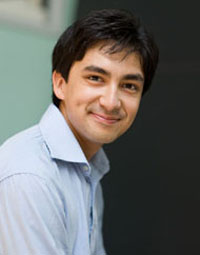This is the latest in a series of profiles of our MIT Energy Fellows — graduate students who are supported by MIT Energy Initiative (MITEI) members to participate in faculty-led research and become part of a long-term community of students and alumni.

Grid-based lighting accounts for up to 20 percent of global electricity consumption, and more than half of U.S. residential lighting relies on incandescent lamps that leak about 95 percent of their input energy as heat.
To make a dent in the energy consumption and cost of solid-state lighting, Geoffrey J. Supran is helping develop quantum dot light-emitting diodes (QD-LEDs). Quantum dots are nanometer-sized, inorganic crystals that create light when stimulated with photons or electrons.
Light-emitting diodes (LEDs), used for decades in electronic devices as low power, colorful, long-lasting lighting sources, have recently been introduced into home and industrial lighting. QD-LEDs are relatively cheap to produce devices based on a thin film of luminescent quantum dots, combined with either organic or inorganic materials. They are slated to launch a new generation of domestic and industrial lighting and offer the possibility of ultrathin, flexible flat-panel displays. QDs can be tuned to emit clear, richly colored light in almost the entire visible spectrum.
Sponsored by MIT Energy Initiative (MITEI) founding member Eni, an Italian multinational oil and gas company, Supran is one of 47 MIT Energy Fellows supported by MITEI member companies in 2009-2010. Supran is a PhD student working with Vladimir Bulović, associate professor of electrical engineering and computer science, in the Organic and Nanostructured Electronics Laboratory.
Solar cells take light in and give out electricity; LEDs do the reverse. “Solar cells and LEDs are intimately related,” Supran said. “LEDs are essentially the flip side of solar energy. It’s as important to work on the demand side as on the supply side of energy production.” Photovoltaic installations currently offset only around one five-thousandth of all U.S. energy usage, in part because of a lack of economic and political incentives and the high cost of solar cell manufacture.
In addition to immediate applications such as improving display technologies and solid-state lighting, QD-LEDs also provide a platform for studying QD physics, which could lead to improvements in other QD-based optoelectronics devices such as QD solar cells, Supran said.
To a physicist, QDs afford a fascinating testbed for the elucidation of fundamental and applied photophysics. “As an engineer and aspiring entrepreneur, the possibility of making tunable, large-area LEDs and solar cells on flexible substrates is very exciting,” he said. “Material availability, scalability, and high efficiency are the three essential requirements for a successful emerging solar technology, and one of my central goals is to define new ways to think about how to design devices and in turn how to attack these issues.”
Captivated by science
Supran’s interests range from investing in property to training for his pilot’s license. Visiting Panama on holiday opened his eyes to the region’s low property prices and high rents, motivating him to pursue property investment there. The venture could dovetail with his interest in solar energy: escalating tourism, rising electricity costs, and year-round sunshine make Panama a blank slate for the development of solar cell infrastructure, he pointed out.
“My parents’ generosity really allowed me to explore a broad spectrum of ambitions,” he said. Growing up in the United Kingdom, Supran started swimming and playing golf and tennis at age two. During primary school, he and his father played 18 holes before school. His coach predicted he would turn professional before 18, but his future lay elsewhere.
Reading about Gregor Mendel’s elucidation of the genetics responsible for inherited traits in pea plants, Supran was struck by “wonder at the possibility of science’s ability to improve the course of humanity. In a way that putting a ball in a hole never could, science unlocks an opportunity to make a permanent contribution, however small, to mankind’s progress,” he said.
Summer research opportunities during high school and college revealed new worlds. “I remember staying up late during high school making telephone calls to professors in the U.S., including Bulović, proposing rather ambitious projects and asking if I could spend the summer in their lab, or if they could send me one of their LEDs for a classroom demonstration.
“It seems that tenacity paid off as I find myself now working with one of those professors!” he said.
MIT’s many opportunities for students related to world-class research and exposure to entrepreneurship all come together through MITEI and its associated energy startups, he said. President Obama’s recent visit to MIT, with a stop in the Bulović laboratory, assured Supran that he is working at the front line of energy research. “This is the challenge of our generation,” he said. “This is a great time to be at MIT.”